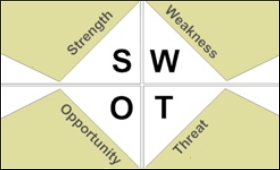|

|
What is your Swot?
|
|

|
|
| Top Stories |
 |
|
|
|
Terry H. Hill | 06 Dec, 2010
An effective tool that assesses and identifies opportunities and risks is a SWOT analysis. A SWOT analysis is a strategic planning tool used to evaluate the strengths, weaknesses, opportunities, and threats involved in a business venture or project. Once a clear objective has been identified, a SWOT analysis can be highly effective in the pursuit of the objective.
SWOT is an acronym for Strengths, Weaknesses, Opportunities and Threats. It's an assessment technique that paints an accurate picture of how your business stacks up based on these four factors. SWOT is a simple, popular way to gather and use information in preparing or amending your business plan. It's also useful in solving problems, making decisions and educating staff when change is necessary.
In brief, SWOT means identifying:
* Strengths--internal factors- such as expertise, innovation, and resources.
* Weaknesses--internal factors- such as a high level of debt, slow moving inventory, and labor shortages.
* Opportunities--external advantages- such as a rapidly growing market where demand outstrips supply.
* Threats--potential external risks- such as natural disasters, competitive price undercutting, and changes in the general business environment.
Calculate SWOT, and you can quickly identify your venture's pros and cons. Aligning internal strengths and weaknesses with external opportunities and threats is essential to sound strategic planning. With SWOT, you know where you stand today and where you are going tomorrow. With SWOT, you can identify and prioritize the issues that will accelerate success.
In the planning stages of jumpstarting your business, SWOT is essential to your business plan--especially if you're looking for capital. Why? Investors appreciate any type of analysis that minimizes their risk. The SWOT analysis identifies internal and external factors that can impact your business success. To calculate SWOT, you need to understand the factors--internal and external--that will affect your progress.
Internal factors are those factors that are within your control and that take place within your business environment:
* Operational issues--the efficiency of your operation.
* Staff and employees--the loss of a key salesperson or supervisor.
* Capacity-- resources available that match supply with demand.
* Cash flow--the timely flow of revenues to pay financial obligations.
* Costs--costs of doing business such as payroll, equipment, and rent.
* Productivity--ability to produce desired number of products or level of service within a given time frame.
External factors are general conditions and environmental factors that are outside of your control:
* The general business environment--interest rates and demographics.
* Economic change--a sudden deterioration in the geographic/regional market or growth in the
Macroeconomic climate
* Industry/market/customer trends.
* Changes in the competitive landscape.
* Technology trends--trends that can be used to your advantage.
* Regulatory environment--changes that can create opportunity.
* Weather issues--whether you are a tennis pro, a painter, or a landscaper, long periods of bad weather can limit revenue-generating opportunities.
* Product availability-- manufacturing materials that you count on are suddenly impossible to obtain.
The purpose of the SWOT analysis is to examine and identify all of these factors, (the likelihood that some or all of the factors will come into play), quantify how they can affect your business, and then develop a contingency plan. Examine each of the internal and external factors and develop reasonable responses.
(Source: Articlesbase)
* Terry H. Hill is freelance writer.
* The views expressed by the author in this feature are entirely his/her own and do not necessarily reflect the views of SME Times.
|
|
|
| |
|
|
|
|
|
|
|
|
|
|
|
|
|
|
| |
| Customs Exchange Rates |
| Currency |
Import |
Export |
US Dollar
|
₹88.70
|
₹87 |
UK Pound
|
₹119.90
|
₹116 |
Euro
|
₹104.25
|
₹100.65 |
| Japanese
Yen |
₹59.20 |
₹57.30 |
| As on 30 Oct, 2025 |
|
|
| Daily Poll |
 |
 |
| Who do you think will benefit more from the India - UK FTA in the long run?
|
|
|
|
|
|
| Commented Stories |
 |
|
|
|
|
|
| |
|